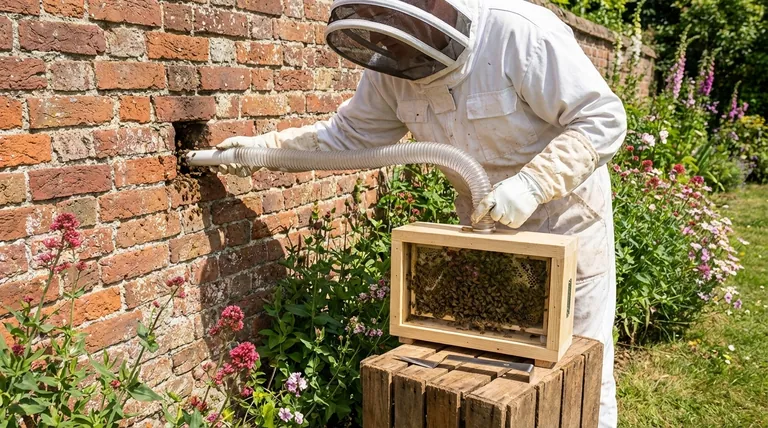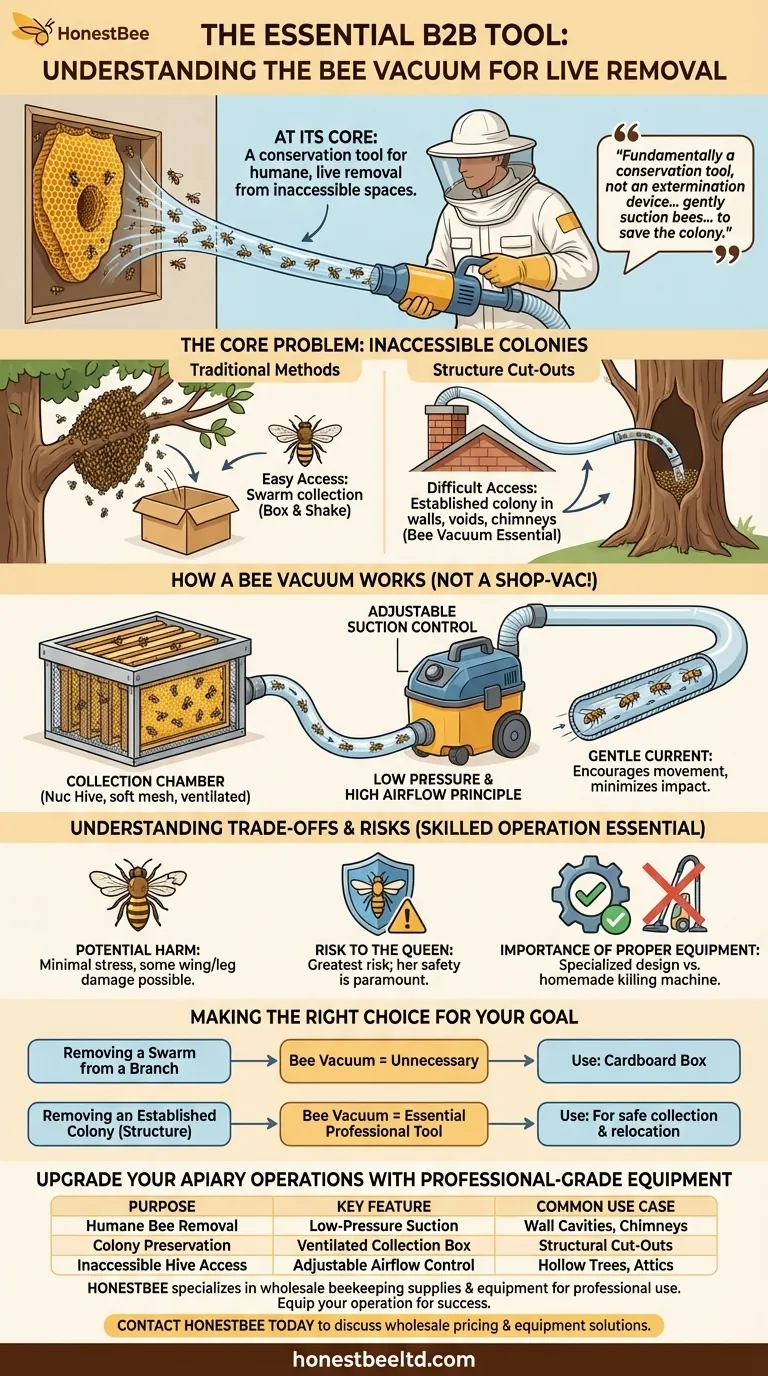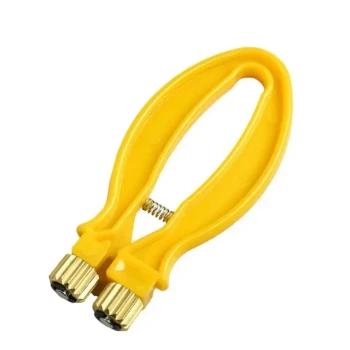At its core, a bee vacuum is used to safely and humanely remove a honey bee colony from a location where it cannot be easily reached. It is a specialized tool for live bee removal, designed to gently collect bees from inaccessible spaces like wall cavities, chimneys, or hollow trees so they can be relocated without harm.
A bee vacuum is fundamentally a conservation tool, not an extermination device. Its purpose is to gently suction bees out of confined spaces to save the colony, allowing it to be moved to a proper hive.

The Core Problem: Inaccessible Colonies
Honey bees often establish their homes in locations that are difficult, if not impossible, to access directly. This is the primary challenge a bee vacuum is designed to solve.
When Traditional Methods Fail
A swarm of bees resting on a tree branch can often be collected by simply shaking them into a box. This is the ideal and gentlest method.
However, once a colony has established comb and brood inside a structure, this is no longer an option. A bee vacuum becomes necessary for these "cut-outs" or structural removals.
Why Not Just Leave Them?
Bees in the walls of a home can create significant problems over time, including the potential for honey to seep through drywall and attract other pests. Removal is often the only responsible long-term solution.
Common Scenarios for Use
The most frequent use cases for a bee vacuum involve colonies that have settled deep inside structures. This includes voids in walls, soffits, attics, chimneys, and hollow trees. The vacuum's hose can reach where a beekeeper's hands cannot.
How a Bee Vacuum Works
It is critical to understand that a bee vacuum is not a standard Shop-Vac. Using a household or industrial vacuum would instantly kill the bees due to excessive suction and impact.
The Principle of Low Pressure
Specialized bee vacuums operate on a principle of low pressure and high airflow. The goal is not to violently suck the bees, but to create a gentle current that encourages them to move through the hose.
The Collection Chamber
Instead of a bag or canister, the bees are drawn into a specially designed collection box. This is often a nucleus hive (nuc) with frames, soft mesh, and proper ventilation. This design ensures the bees have a soft landing and a calm, dark space to gather, minimizing stress and injury.
Controlling the Suction
Most bee vacuums have an adjustable gate or vent system. This allows the operator to precisely control the level of suction. The vacuum can be dialed down to be extremely gentle, especially when the queen is thought to be nearby.
Understanding the Trade-offs and Risks
While a bee vacuum is an invaluable tool for live removal, its use is not without risks to the colony. A skilled operator is essential to minimize harm.
Potential Harm to Bees
Even with a well-designed vacuum, some bees may suffer damage to their wings or legs. The stress of the experience can also lead to a small number of casualties. The goal is always to keep these losses to an absolute minimum.
Risk to the Queen
The single greatest risk is harming the queen. If she is injured or killed during the vacuuming process, the long-term survival of the colony is jeopardized. Operators are often extremely cautious and may try to locate and cage the queen manually before vacuuming the rest of the bees.
The Importance of Proper Equipment
Using a poorly designed, homemade vacuum without proper pressure controls or a safe collection chamber is a death sentence for the colony. The difference between a rescue tool and a killing machine lies entirely in its design and operation.
Making the Right Choice for Your Goal
Understanding the purpose of a bee vacuum helps clarify when it is the appropriate solution.
- If your primary focus is removing a swarm from a tree branch: A bee vacuum is unnecessary and overly aggressive. A cardboard box and a bit of shaking is the safest and most effective method.
- If your primary focus is removing an established colony from inside a structure: A bee vacuum is the essential professional tool for safely collecting the bees so the comb can be removed and the colony relocated.
- If you are a homeowner with bees in your walls: Do not attempt this yourself. Contact a professional beekeeper who specializes in live removals and has the proper equipment, including a bee vacuum.
Ultimately, the bee vacuum is a testament to the beekeeper's commitment to preserving honey bee populations, providing a humane solution for the most challenging removals.
Summary Table:
| Purpose | Key Feature | Common Use Case |
|---|---|---|
| Humane Bee Removal | Low-Pressure Suction | Wall Cavities, Chimneys |
| Colony Preservation | Ventilated Collection Box | Structural Cut-Outs |
| Inaccessible Hive Access | Adjustable Airflow Control | Hollow Trees, Attics |
Upgrade Your Apiary Operations with Professional-Grade Equipment
For commercial apiaries and beekeeping equipment distributors, having reliable, humane tools is essential for both colony health and operational efficiency. HONESTBEE specializes in wholesale beekeeping supplies and equipment designed for professional use.
We provide beekeepers with the tools needed for successful live removals and sustainable hive management. Let us help you equip your operation with gear that protects both your bees and your business.
Contact HONESTBEE today to discuss wholesale pricing and equipment solutions tailored to your needs.
Visual Guide

Related Products
- HONESTBEE Professional Long Handled Hive Tool with Precision Cutting Blade
- HONESTBEE Advanced Ergonomic Stainless Steel Hive Tool for Beekeeping
- Professional Dual-End Stainless Steel Hive Tool for Beekeeping
- HONESTBEE Professional Multi-Functional Hive Tool with Ergonomic Wood Handle
- Professional 3-Bar Frame Grip with Integrated Hive Tool
People Also Ask
- What is a hive tool used for in beekeeping? Your Essential Guide to Hive Management
- What is the hive tool used for? The Essential Multi-Tool for Every Beekeeper
- What are the basic tools for beekeeping? Essential Starter Kit for Safe & Successful Hive Management
- What is a hive tool and what are its uses? Master Your Hive Inspections with the Essential Beekeeper's Tool
- Why do hive tools have a hole? Unlock the Secret to Efficient Beekeeping



















